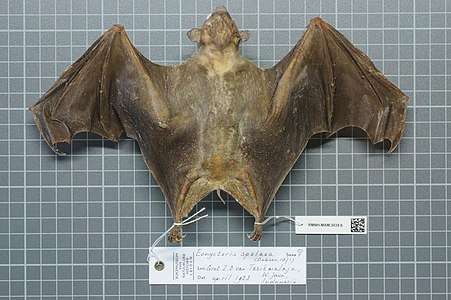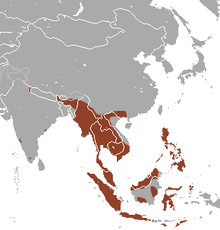Cave nectar bat
| Cave nectar bat | |
|---|---|
 | |
| Scientific classification | |
| Kingdom: | Animalia |
| Phylum: | Chordata |
| Class: | Mammalia |
| Order: | Chiroptera |
| Superfamily: | Pteropodoidea |
| Family: | Pteropodidae |
| Subfamily: | Macroglossinae |
| Genus: | Eonycteris |
| Species: | E. spelaea |
| Binomial name | |
| Eonycteris spelaea (Dobson, 1871) | |
 | |
| Cave Nectar Bat range | |
| Synonyms[1] | |
Cave nectar bat (Eonycteris spelaea), common names also include dawn bat, common dawn bat, common nectar bat and lesser dawn bat,[1] is a species of megabat within the genus Eonycteris. The scientific name of the species is first published by Dobson in 1871.
Description
The upper parts of the Cave nectar bat are grey-brown to dark brown to black. The underparts are paler and the neck is sometimes yellowish brown. The muzzle of this bat is elongated, and particularly adapted for drinking nectar. The species has as well an external tail. The head and body length measures 8.5–11 cm (3.3–4.3 in), the tail length is about 1.5–1.8 cm (0.59–0.71 in) and the forearm length measures 6–7 cm (2.4–2.8 in)[2]
Habits and habitat
The Cave nectar bat is found in primary forests and in disturbed and agricultural areas. It roosts in caves, in larger groups, with some roosts exceeding 50,000 individuals, and it sometimes roosts with other bat species. But in some places, this species seems to have adapted well to leafy, semi-urban habitats. E. spelaea travels many kilometres each night in search of the nectar of flowering trees and shrubs. Because of that, this bat species is a very important pollinator of fruit trees, such as durians,[2] notably both Durio zibethinus and Durio graveolens.[3][4][5]
Distribution
E. spelaea lives in Bangladesh,[6] Brunei, Cambodia, Indonesia (Java, Kalimantan, Sumatra, Sulawesi and some other small islands), Laos, Malaysia, Myanmar, Philippines, Singapore, Thailand, Vietnam, China, India and Timor-Leste.[2] It had been previously recorded from Gomantong Caves, Sukau, Segama, and Madai in Sabah; Niah, Sungai Tinjar, and Kuching in Sarawak; and Sungai Tengah and Kutai in Kalimantan.[7]
Conservation
References
- 1 2 3 Francis, C.; Rosell-Ambal, G.; Tabaranza, B.; Carino, P.; Helgen, K.; Molur, S. & Srinivasulu, C. (2008). "Eonycteris spelaea". The IUCN Red List of Threatened Species. 2008: e.T7787A12850087. doi:10.2305/IUCN.UK.2008.RLTS.T7787A12850087.en. Retrieved 24 December 2017.
- 1 2 3 Shepherd, Chris R.; Shepherd, Loretta Ann (2012). A Naturalist's Guide to the Mammals of Southeast Asia. Wiltshire, UK: John Beaufoy Publishing. p. 22. ISBN 978-1-906780-71-5.
- ↑ Soepadmo, Engkik; Eow, BK (31 August 1977). Mabberley, DJ; Lan, Chang Kiaw, eds. "The Reproductive Biology of Durio zibethinus Murr" (pdf). The Gardens' Bulletin, Singapore. 29: 25–33. ISSN 2382-5812. OCLC 918436212. Retrieved 12 November 2017.
- ↑ Start, A.N.; Marshall, A.G. (1976). "Nectarivorous Bats as Pollinators of Trees in West Malaysia". In Burley, J.; Styles, B.T. Tropical Trees: Variation, Breeding and Conservation. Linnean Society Symposium Series. 2. London, UK: Academic Press. pp. 141–159. ISBN 978-0121451509. OCLC 476102040.
- ↑ Brown, Michael J. (1997). Arora, R.K.; Ramanatha Rao, V.; Rao, A.N., eds. Durio, a Bibliographic Review (PDF). New Delhi, India: International Plant Genetic Resource Institute. p. 13. ISBN 9789290433187. OCLC 38754437. Retrieved 11 November 2017.
- ↑ https://portals.iucn.org/library/sites/library/files/documents/RL-549.3-003-v.2.pdf
- ↑ J. Payne; C. M. Francis; K. Phillipps (1985). A field guide to the mammals of Borneo. Kota Kinabalu, Sabah: The Sabah Society. ISBN 978-967-99947-1-1.
- ↑ Mickleburgh, S., Waylen, K., & Racey, P. (2009). Bats as bushmeat: a global review. Oryx, 43(02), 217-234.
